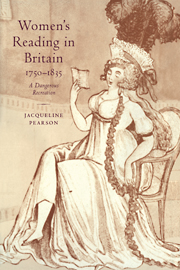Book contents
- Frontmatter
- Contents
- Preface
- Introduction
- 1 Pygmalionesses and the pencil under the petticoat: Richardson, Johnson and Byron
- 2 What should girls and women read?
- 3 The pleasures and perils of reading
- 4 Pleasures and perils of reading: some case histories
- 5 Where and how should women read?
- 6 Preparing for equality: class, gender, reading
- 7 A dangerous recreation: women and novel-reading
- Conclusion
- Notes
- Select bibliography
- Index
Conclusion
Published online by Cambridge University Press: 22 October 2009
- Frontmatter
- Contents
- Preface
- Introduction
- 1 Pygmalionesses and the pencil under the petticoat: Richardson, Johnson and Byron
- 2 What should girls and women read?
- 3 The pleasures and perils of reading
- 4 Pleasures and perils of reading: some case histories
- 5 Where and how should women read?
- 6 Preparing for equality: class, gender, reading
- 7 A dangerous recreation: women and novel-reading
- Conclusion
- Notes
- Select bibliography
- Index
Summary
Books and reading were vital to women in the late eighteenth and early nineteenth century, offering job-opportunities to women in a catastrophically shrinking jobs-market, and occupying time for middle-class women increasingly defined as a leisured rather than productive group. Study of their reading not only allows a glimpse of an apparently minor issue: in some important respects it takes us to the heart of a series of cultures, and their characteristic anxieties, evasions and contradictions, those things they thought too obvious to articulate, and those things they could not articulate at all.
Texts of all kinds draw constant attention to the figure of the woman reader: fictional female characters are defined through their reading; novels employ extraordinary intertextual strategies in which the female characters in the book we are reading discuss the books they are reading. Our activity as readers is kept constantly before us, directing our own reading strategies, creating a rich self-consciousness. Women's reading is depicted, though, in highly contradictory ways. The good girl reads books with ‘pleasure’ yet pleasure is deeply problematic; reading may be seductive or protect from seduction; it is a means of emotional maturation or perpetual juvenility; informative reading constructs a virtuous subjectivity or encourages vanity and folly; reading fosters or compromises good domestic relations.
What is finally, to me, the most surprising thing is not the age's anxieties about the woman reader, its elision of sexuality and textuality, the difficult tightrope act required of the woman reader, the repetitiveness of discourses especially of fiction-reading with their constant use of words like ‘dangerous’, ‘seductive’, ‘poison’ and ‘soften’, or even their deeply self-contradictory nature.
- Type
- Chapter
- Information
- Women's Reading in Britain, 1750–1835A Dangerous Recreation, pp. 219 - 220Publisher: Cambridge University PressPrint publication year: 1999



